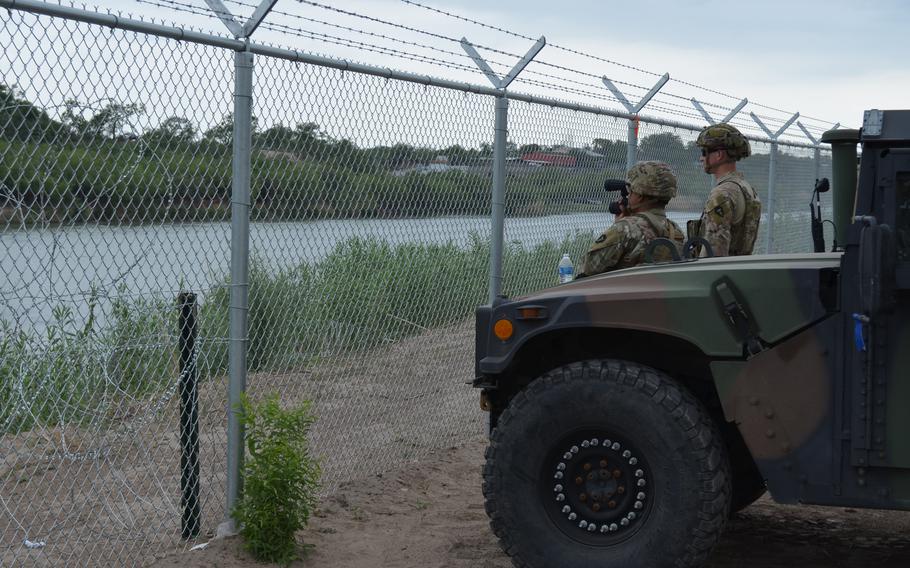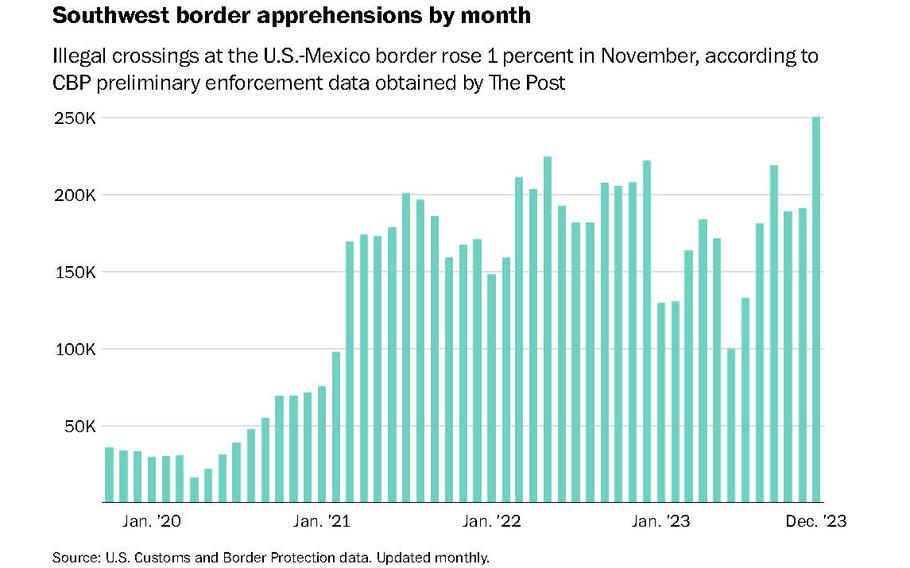U.S.
US released more than 2.3 million migrants at border since 2021, report says
The Washington Post January 7, 2024

Texas National Guard troops watch for illegal activity along the Rio Grande near Eagle Pass, Texas, in May 2022. (Rose L. Thayer/Stars and Stripes )
U.S. Customs and Border Protection has released more than 2.3 million migrants into the United States at the southern border under the Biden administration, allowing in the vast majority of migrant families and some adult groups, according to a new report.
The figures, published by the Department of Homeland Security for the first time, illustrate the extent to which CBP officials have been overwhelmed by the volume of migrants crossing the U.S.-Mexico border. The mass releases have typically been a measure of last resort when agents don’t have the holding capacity or personnel to process migrants using standard procedures.
The 2.3 million figure is significantly lower than the more than 6 million migrants taken into CBP custody during the same period, a number many of President Biden’s Republican critics have used as a proxy for overall migration.
Homeland Security Secretary Alejandro Mayorkas acknowledged the rising numbers this week and said released migrants are put into deportation proceedings. But he said it takes too long to deport people who are ineligible to stay, and urged Congress to boost the agency’s funding.
“It is precisely why we have said since day one of this administration that the immigration system that is so fundamentally broken needs to be fixed,” Mayorkas told Fox News on Thursday.
DHS did not respond to a request for comment on Saturday.
The DHS data released Friday show more than 4 million border-crossers have been expelled to Mexico, returned to home countries or otherwise removed from the United States over the past three years.
The 4 million figure includes more than 2.5 million migrants who were expelled by CBP using the pandemic-era Title 42 policy that allowed border agents to rapidly return migrants to Mexico or their home countries without giving them a chance to seek U.S. protection. The policy, which the Biden administration ended in May, partly inflated CBP encounter numbers because it allowed border-crossers to make repeat attempts without fear of legal consequences such as jail time.

(The Washington Post)
The figures in the report were produced by the agency’s new Office of Homeland Security Statistics, a unit created last year to provide more data to the public at a time when immigration remains a major political issue nationwide.
CBP mass releases are taxing for U.S. communities because large groups of migrants, including families with children, often arrive needing shelter, meals and services. Texas Gov. Greg Abbott (R) has sent nearly 100,000 migrants to U.S. cities such as Chicago, New York and Washington, straining their finances and fanning tensions between their Democratic mayors and the White House.
The Border Patrol, which is part of CBP, released 1.8 million migrants into the United States during the last three years, including a record 909,450 during the 2023 fiscal year that ended Sept. 30, the DHS data show.
The Border Patrol typically releases migrants if they are traveling with children to avoid holding them in crowded detention facilities with adults. Agents also release migrants when detention facilities are beyond capacity.
CBP’s Office of Field Operations, which monitors legal checkpoints bustling with travelers and international trade, also released an additional 487,830 migrants in the last three years, most of them in the 2023 fiscal year. Though they arrived at an official port of entry, these migrants may still ultimately be deported if they do not qualify for U.S. legal status.
Families made up the majority of the 2.3 million released by CBP. The DHS data show about 70% of all the families who were taken into U.S. custody over the last three years were released along the border. In 2023, the percentage of families who were released — and not sent home or returned to Mexico — rose to 81%.
Adults traveling without children are released by CBP at a much lower rate, the DHS data show. About 1 million adults taken into CBP custody were released, accounting for about one-quarter of those apprehended by the agency.
The 2.3 million releases by CBP do not include the roughly 365,000 unaccompanied minors encountered by the agency since 2021 who were transferred to the Department of Health and Human Services. The minors are generally assigned to federal shelters and later released to a parent or guardian.
Migrant families crossing the U.S.-Mexico border have been rising over the past decade, and they pose a special concern for federal immigration officials because detention centers are built for adults and federal courts have imposed limits on how long officials can detain children.
The Trump administration said it was forced to release families because it could not detain children longer. In 2019, when the Trump administration faced a then-record influx of migrants traveling as family groups, the CBP made more than 258,000 direct releases, including many families, a period when CBP officials said their agents and infrastructure had reached “a breaking point.”
The Biden administration ended family detention because officials said children should not be in custody, but that has also meant that traveling as a family increases a group’s odds of entering the United States. Many families are making journeys through dangerous jungles and crime-ridden areas to reach the border, and children often arrive sick and underweight. Some children have died on the journey and in U.S. custody.
Migrants are required to check in with immigration officials to face deportation proceedings once they are settled in the United States. Many do, but some do not, leading to large immigration court backlogs and concerns that immigration officials are unable to deport migrants who are ineligible to stay.
Border officials have exercised their authority to release migrants in the past, but more sparingly, such as to admit people seeking medical care or fleeing persecution.
From the fiscal years 2014 to 2020, 463,110 migrants were released into the United States from the southern border. Part of Biden’s first year overlapped with Trump’s, though Biden has been more likely to allow migrants into the United States. The data does not take into account migrants who slipped past border guards and got into the United States.
Venezuelans were the largest group released over the past three fiscal years, with more than 382,600 passing through border facilities. Cubans were the second largest, with more than 316,000 releases, followed by more than 200,000 each from Nicaragua and Honduras.
Others have been allowed into the United States through a parole program meant to discourage them from crossing the southern border illegally. More than 350,000 migrants were allowed in at airports, mainly through a program that grants legal entry to Cubans, Haitians, Venezuelans and Nicaraguans if they find a U.S. resident to sponsor them.
U.S. Immigration and Customs Enforcement, which is responsible for detaining and deporting migrants inside the United States, also releases some migrants after receiving them from CBP.
ICE has enrolled more than 650,000 migrants into electronic monitoring programs known as “alternatives to detention” since the 2021 fiscal year, records show. The number includes individuals taken into custody by CBP at U.S. land borders as well as those arrested by ICE in the interior of the United States.
The report does not include estimates for the number of border-crossers who were detected by CBP but not taken into custody, a category the agency refers to as “gotaways.” CBP detected about 600,000 gotaways in 2022 and 389,000 in 2021, according to a May 2023 report by DHS’s Office of Inspector General.